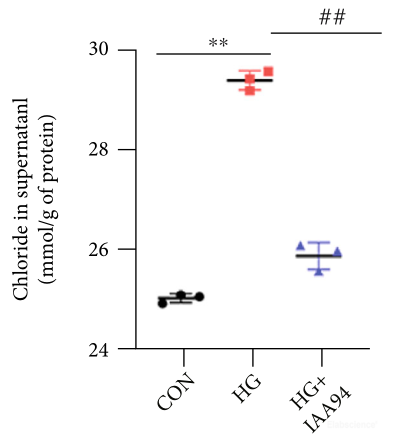Chlorine (Cl) Colorimetric Assay Kit
SKU: E-BC-K189-M-500
Chlorine (Cl) Colorimetric Assay Kit
| SKU # | E-BC-K189-M |
| Detection Instrument | Microplate reader (440 nm-480 nm, optimum wavelength: 460 nm) |
| Detection method | Colorimetric method |
Product Details
Properties
| Synonyms | Cl |
| Sample Type | Serum, plasma, animal tissue |
| Sensitivity | 1 mmol/L |
| Detection Range | 1.0-60 mmol/L |
| Detection Method | Colorimetric method |
| Assay type | Quantitative |
| Assay time | 15 min |
| Precision | Average inter-assay CV: 6.400% | Average intra-assay CV: 3.600% |
| Other instruments required | Micropipettor, Tubes, Vortex mixer, Incubator, Centrifuge. |
| Storage | 2-8℃ |
| Valid period | 12 months |
Images
SH Li et al investigate the diabetic cardiomyopathy induced by sleeve gastrectomy.. Chloride (Cl) concentration in cell supernatant was determined using chloride colorimetric assay kit (E-BC-K189-M).

The chloride concentration in supernatant was significantly increased in HG group and reduced in IAA94 treated group. (**P<0.01 vs. CON, ##P<0.01 vs. HG)
Dilution of Sample
It is recommended to take 2~3 samples with expected large difference to do pre-experiment before formal experiment and dilute the sample according to the result of the pre-experiment and the detection range (1.0-60 mmol/L).
The recommended dilution factor for different samples is as follows (for reference only):
| Sample type | Dilution factor |
| 10% Mouse liver tissue homogenate | 2-3 |
| 10% Mouse kidney tissue homogenate | 2-3 |
| 10% Rat spleen tissue homogenate | 2-3 |
| Human serum | 5-10 |
| Mouse serum | 5-10 |
| Cynomolgus monkey serum | 5-10 |
Note: The diluent is double distilled water.
Detection Principle
Chloride ion in biological fluids are replaced by the mercury ions in mercury thiocyanate through ion replacement, which resulted in the formation of difficult-to-dissociate mercury chloride. The substituted thiocyanate ions were combined with ferric nitrate to form a red complex. The content of chlorine ion can be calculated indirectly by measuring the OD value at 460 nm.
Kit Components & Storage
| Item | Component | Size 2(96 T) | Storage |
| Reagent 1 | 100 mmol/L Standard Solution | 1 mL × 1 vial | 2-8°C, 12 months |
| Reagent 2 | Chromogenic Agent A | 10 mL × 1 vial | 2-8°C, 12 months |
| Reagent 3 | Chromogenic Agent B | 20 mL × 1 vial | 2-8°C, 12 months, shading light |
| Reagent 4 | Chromogenic Agent C | 1 mL × 1 vial | 2-8°C, 12 months |
| Microplate | 96 wells | No requirement | |
| Plate Sealer | 2 pieces |
Note: The reagents must be stored strictly according to the preservation conditions in the above table. The reagents in different kits cannot be mixed with each other. For a small volume of reagents, please centrifuge before use, so as not to obtain sufficient amount of reagents.
Technical Data:
Parameter:
Intra-assay Precision
Three human serum samples were assayed in replicates of 20 to determine precision within an assay. (CV = Coefficient of Variation)
| Parameters | Sample 1 | Sample 2 | Sample 3 |
| Mean (mmol/L) | 15.50 | 34.80 | 50.50 |
| %CV | 3.9 | 3.6 | 3.3 |
Inter-assay Precision
Three human serum samples were assayed 20 times in duplicate by three operators to determine precision between assays.
| Parameters | Sample 1 | Sample 2 | Sample 3 |
| Mean (mmol/L) | 15.50 | 34.80 | 50.50 |
| %CV | 6.1 | 6.7 | 6.4 |
Recovery
Take three samples of high concentration, middle concentration and low concentration to test the samples of each concentration for 6 times parallelly to get the average recovery rate of 105%.
| Standard 1 | Standard 2 | Standard 3 | |
| Expected Conc. (mmol/L) | 8.4 | 22 | 45 |
| Observed Conc. (mmol/L) | 8.5 | 23.8 | 47.7 |
| Recovery rate (%) | 101 | 108 | 106 |
Sensitivity
The analytical sensitivity of the assay is 1 mmol/L. This was determined by adding two standard deviations to the mean O.D. obtained when the zero standard was assayed 20 times, and calculating the corresponding concentration.
Standard Curve
As the OD value of the standard curve may vary according to the conditions of the actual assay performance (e.g. operator, pipetting technique or temperature effects), so the standard curve and data are provided as below for reference only
| Concentration (mmol/L) | 0 | 5 | 10 | 20 | 30 | 40 | 50 | 60 |
| Average OD | 0.064 | 0.096 | 0.134 | 0.198 | 0.255 | 0.296 | 0.361 | 0.408 |
| Absoluted OD | 0.000 | 0.032 | 0.069 | 0.134 | 0.191 | 0.232 | 0.297 | 0.343 |



